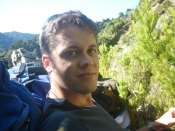How can I teach more like Mr Becker?
In the last few months I have had the pleasure of reading a book by Bruce VanSledright called The Challenge of Rethinking History Education: On Practices, Theories, and Policies (2011). Not the most inspiring title (or cover), but it is a book that has got me thinking more seriously about the nature of history teaching than I have for a long time. This blog post isn't a review of VanSledright's book but a brief discussion about the implications I think it will have for my teaching in the immediate future.
First, a very brief summary is necessary. VanSledright introduces his book with two short vignettes of two classroom teachers with very different pedagogical practices and purposes. One teacher, Mr Brinton, specialises in “collective memorisation” transmitted by “persistent instruction”. In stark contrast, the other teacher (Ms Todd) runs a classroom “in which participants debate ideas, cite evidentiary support for their positions, dispute others’ claims, and, in the end, agree to disagree” (VanSledright, p.13). Having established Todd’s approach as far more desirable (although relatively rare), the book then focuses on the teaching of a made-up teacher called Mr Becker who embodies what VanSledright calls the investigative approach to teaching history.
Mr Becker is somewhat terrifying; he has been teaching for 4 years and has a depth and quality about his thinking that seems extraordinary. But on the other hand he is inspiring. What he does is not magic, just unusual. So, how can I teach more like him? There is one practical change I have started to make.
Mr Becker, when teaching about Andrew Jackson’s persecution of the Cherokee, draws on a large range of primary sources that he has gathered up over the years and put into a file. Since reading this book I now realise I need to be much more methodical about gathering different types of sources if I am serious about my students developing their own well-reasoned, evidence-based accounts of the past. To aid this I have set up a historical sources database and index (see attachment for the index). As I read a history book I jot down any source the author refers to that I find particularly interesting or a section of the book itself that I think might come in useful one day. When finished reading the book I write the notes in my index, including what interesting inquiry questions they could relate to and if the source is an historical account or trace. Some authors reference extensive pieces of evidence. I have started photocopying these and filling up a digital database linked to the index. So far this process has not distracted from the pleasure of reading the book and I feel I am gathering a set of resources that will be useful for the rest of my teaching career.
There is much more to be gained from this book and it is definitely the kind that demands a re-read. It was a privilege to feel like I was a fly on the wall in a classroom of a great teacher. However, I do have some concerns that VanSledright’s book did not address and which perhaps it couldn’t. The hardest part about teaching history is weaving a context of motivation for not always interested students so that they start asking authentic questions about sources, people in the past, and what it all means for their own lives. This requires more than the teacher having a deep sense of the nature of history and a comprehensive set of sources on hand. Students need what Sydney J Harris calls authentic teachers:
“For genuine authority, which is more than a matter of official position and the ability to reward and punish, comes out of the depths of personality. It has a realness, a presence, and aura that can impress and influence even a six-year old. A person is either himself or not himself; is either rooted in his existence, or is a fabrication; has either found his humanhood or is still playing with masks and roles and status symbols. And nobody is more aware of this difference (although unconsciously) than a child. Only an authentic person can evoke a good response in the core of the other person. Only person is relevant to person.”
All good teachers aspire to authenticity like this. Sometimes it is easy to forget that the hardest part about teaching history has nothing to do with reading books, writing blog posts or attending conferences.
References
VanSledright, B. (2011), The Challenge of Rethinking History Education: On practices, Theories, and Policy, Routledge: New York.


